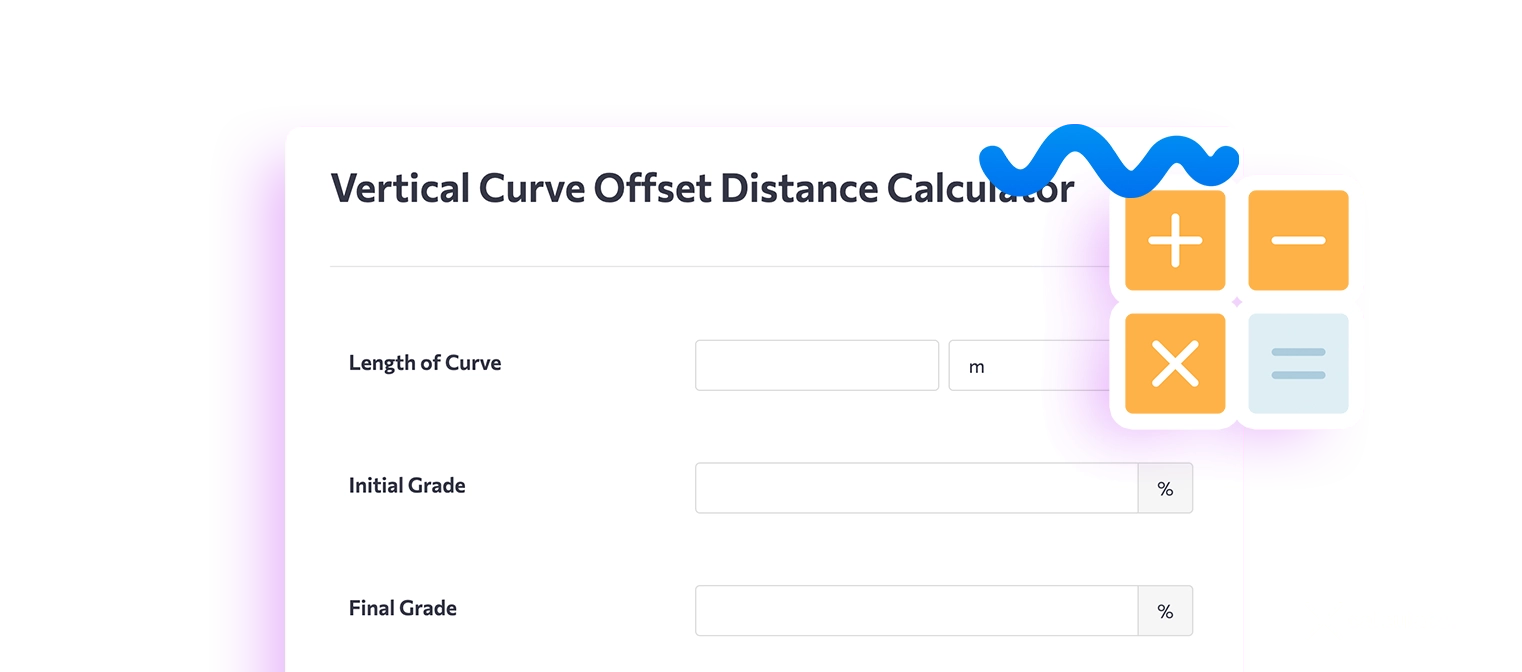In road design, vertical curves are critical elements that ensure a smooth transition between different gradients or slopes of the road. Vertical curves connect an uphill slope to a downhill slope (crest curve) or vice versa (sag curve). Proper vertical curve design ensures driver comfort, safety, and maintaining sight distances. One of the critical calculations in vertical curve design is the offset distance calculation, which helps to determine the curve’s height (or depth) at any given point between the initial and final grades.
Key Terminologies
- Vertical Curve: A smooth, parabolic curve connecting two roadway grades.
- Offset Distance (y): The vertical distance between the actual elevation of the curve at a specific point and the corresponding point on the tangent line that connects the beginning and end of the curve.
- Tangents: The straight-line segments before and after the vertical curve represent the roadway’s slope without curvature.
- Curve Length (L): The total horizontal distance from the beginning to the end of the vertical curve.
- Crest Curve: A vertical curve that transitions from an uphill to a downhill slope.
- Sag Curve: A vertical curve that transitions from a downhill slope to an uphill slope.
Importance of Offset Distance in Vertical Curves
The offset distance is essential for engineers because it helps determine the curve’s shape and how much the roadway deviates from the straight tangent lines. It gives us the height or depth of the vertical curve at various points along its length. For a crest curve, the offset distance tells us how much higher the curve is compared to the tangents, while for a sag curve, it shows how much lower the curve dips.
This calculation is critical for ensuring the following:
- Safety: Ensuring drivers have adequate sight distance to see objects or vehicles ahead.
- Comfort: Avoid sharp or abrupt transitions that could cause discomfort to vehicle occupants.
- Road Design: Achieving a balance between geometric design and construction feasibility.
Parabolic Nature of Vertical Curves
Vertical curves are typically designed as parabolas because a parabolic shape provides a gradual, smooth transition between two different roadway grades. Engineers can use a parabola to create a curve that minimizes drivers’ discomfort while maintaining the necessary sight distance for safe driving.
The offset distance for a vertical curve is derived from the parabola equation. This parabolic equation allows engineers to determine the elevation of any point along the curve.
Steps for Calculating Vertical Curve Offset Distance:
- Determine the Roadway Grades:
- Identify the initial grade G1 (before the vertical curve starts) and the final grade G2 (after the vertical curve ends).
- Measure or Calculate the Curve Length:
- The total length L of the vertical curve is the horizontal distance between the curve’s beginning and end. This length is usually provided in design plans or calculated based on road geometry requirements.
- Select the Point of Interest:
- Choose the point x along the curve where you want to calculate the offset distance. This is the horizontal distance from the curve’s start to the point of interest.
- Use the Offset Distance Formula:
- Plug the G1, G2, L, and x values into the offset distance formula to calculate y, the vertical offset at the point x.
Applications of Offset Distance in Road Design
- Ensuring Adequate Sight Distance:
- Offset distance calculations help determine whether drivers will have sufficient sight distance along the curve. This is particularly important on crest curves, where drivers may be unable to see oncoming traffic or obstacles beyond the curve’s peak.
- Vertical Clearances:
- For sag curves, offset distances help evaluate the vertical clearance under bridges or tunnels, ensuring that the road curve doesn’t dip too low.
- Drainage Considerations:
- Properly calculated vertical curves ensure the road’s surface allows for adequate drainage. For example, if the offset is too deep in sag curves, water may accumulate, leading to safety hazards like hydroplaning.
- Driver Comfort and Vehicle Dynamics:
- Smooth vertical curves, characterized by gentle offset distances, ensure that vehicles transition between grades without causing discomfort to passengers or excessive strain on the vehicle’s suspension system.
Offset Distance for Crest vs. Sag Curves
- For crest curves, the offset distance indicates how much the curve rises above the tangent line, peaking at the midpoint. The longer the curve, the smaller the offset for the exact grade change, which results in a gentler curve.
- For sag curves, the offset distance shows how much the road dips below the tangent line. This is important for determining how the curve will affect vehicle dynamics, especially at night, as the dip can affect headlight coverage and visibility.
Advanced Considerations: Superelevation and Transition Curves
In some road designs, the vertical curve may also interact with horizontal curves, necessitating adjustments to the offset calculations. In these cases, superelevation (banking of the road) and transition curves (gradual shifts in curvature) must be factored into the overall design. These adjustments ensure vertical and horizontal alignments provide a smooth and safe driving experience.
Conclusion
The Vertical Curve Offset Distance Calculator is an essential tool in highway engineering for designing smooth, safe, and comfortable transitions between different road grades. By accurately calculating the offset distance, engineers can ensure that roadways provide adequate sight distance, proper drainage, and safe vertical clearances. Whether designing crest or sag curves, this calculation helps create roads that meet safety standards and provide a comfortable driving experience, ultimately reducing the risk of accidents and improving the overall functionality of the transportation infrastructure.
Vertical Curve Offset Distance formula
Where:
- E – Vertical Offset
- g1 – Initial grade
- g2 – Final grade
- L – Length of the curve
The Vertical Curve Offset Distance Calculator makes it easy to calculate the middle ordinate when designing highways online.


